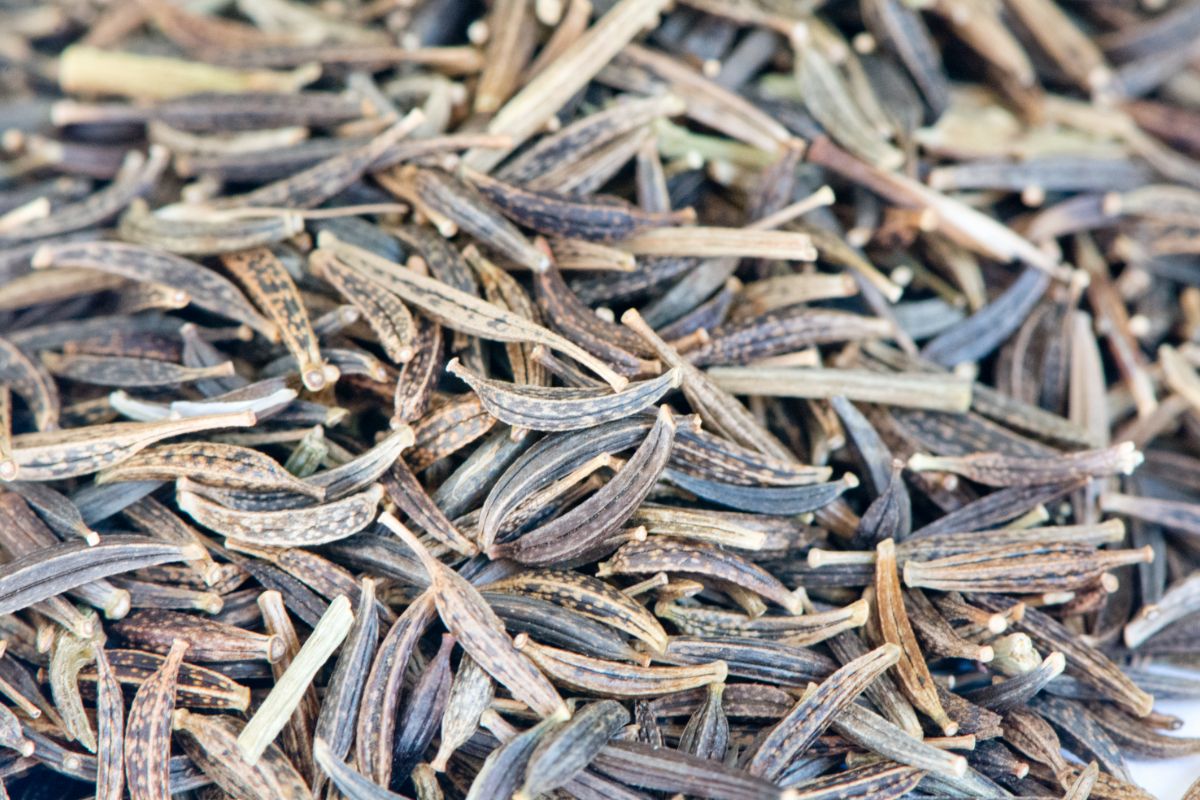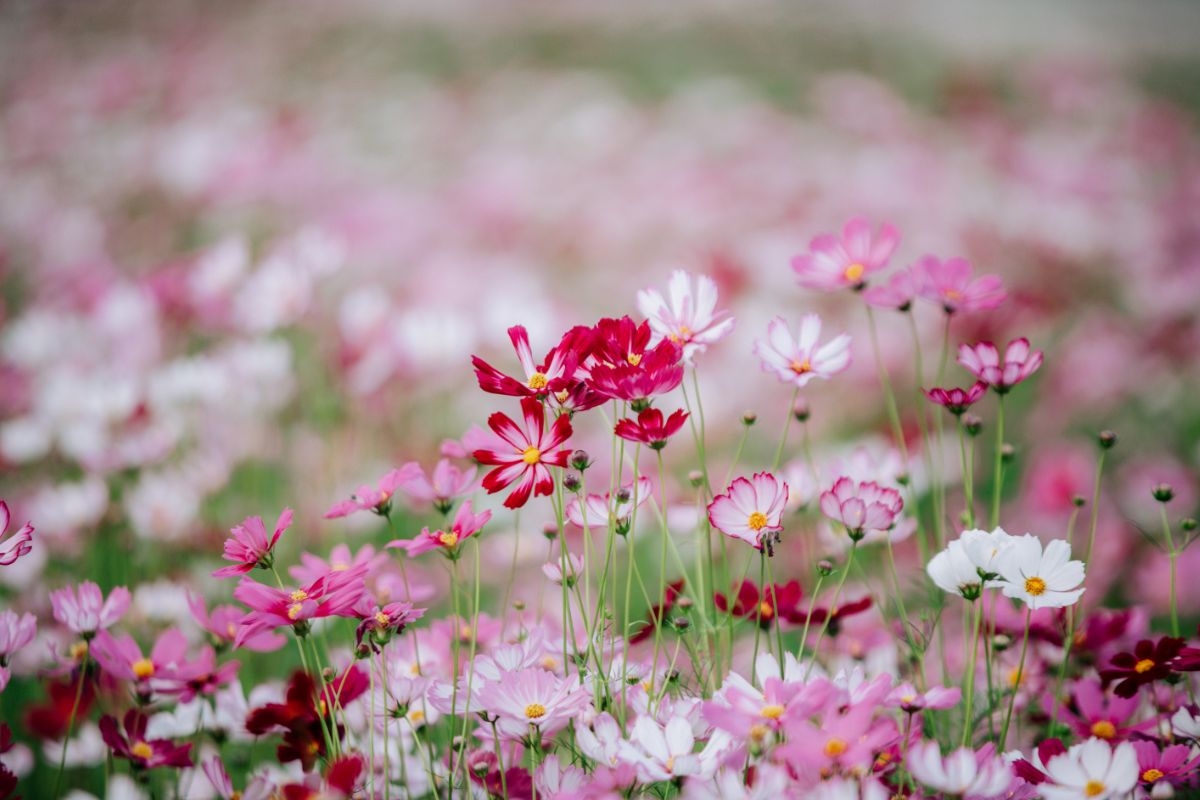Cosmos is a beautiful, colorful flower that can brighten up any garden. Growing cosmos from seeds is a great way to add a splash of color to your outdoor space.

Cosmos are easy to grow and require minimal care, making them an ideal choice for the novice gardener or those looking for an easy-care addition to their garden. Read on to learn more about how to grow cosmos from seed.
Growing Your Own Cosmos From Seed To Flower
Growing your own cosmos from seed is an easy and fun activity that kids of all ages can enjoy participating in. It’s incredibly rewarding to guide them through the necessary steps to planting their seeds indoors or even sowing outdoors in the sunlight.
The beautiful blooms that come out when they have been tended to properly will bring delight and happiness during the summer, and with their mesmerizing colors comes a sense of accomplishment in any child.
What Do You Need To Do To Prepare?
Choose The Right Location
Cosmos prefer full sun and well-drained soil. If you’re planting in containers, choose a pot with plenty of drainage holes to prevent overwatering.
Prepare The Soil
Before planting, loosen the soil and work in some compost or other organic matter. This will help improve drainage and add nutrients to the soil.
Planting Your Own Cosmos Indoors – Step By Step
For those eager to get a start on the gardening season, planting cosmos seeds indoors is a great way to get kids involved in an easy and fun activity.
- To begin, cut the very top off of your egg carton and turn the bottom of it upside-down.
- Poke holes into each of your egg compartments and place them directly on the top of the lid, exactly like a tray.
- Now it’s time to fill all your egg cartons with potting soil.
- Take two or three cosmos seeds and place them in each cavity about half an inch deep before lightly covering them with some loose soil.
- Put your egg carton in a warm spot and keep it moist by misting it twice daily until the seedlings start sprouting, which usually happens within one to two weeks.
- Let your little ones monitor daily growth and ensure that they are changing the water if needed, as small indoor containers can dry out quickly.
- When roots have filled up the entire cavity, carefully transport them outside for further growth.
Gardening is an excellent lesson in patience so make sure to involve your children throughout this entire process from planting to harvesting!
Direct Sowing Cosmos From The Seed – Step By Step
This method can be an easy and rewarding experience for any gardener. Cosmos readily reseeds itself, making it a great option for gardeners looking for easy-care flowers that don’t need regular replanting or care.
- For the best success with direct sowing, choose a spot in your garden with the most sun and enough room for the plants to be able to spread out, and plant the seeds roughly 12 to 18 solid inches apart.
- When you’re ready to sow the seeds, it is important not to bury them too deep – just give them a dusting of soil – before patting them down with your hands and keeping them lightly moist.
A benefit of direct sowing cosmos is that they are heat-loving flowers, so there’s no need to wait until midsummer to get started either; seeds can be planted as soon as soil temperatures reach above 55 degrees Fahrenheit.
Aside from this minimal amount of maintenance required throughout the season, the cosmos will generally take care of themselves and provide beautiful blooms without additional work from even the most novice of gardeners!
How To Get Cosmos To Flower?
Cosmos plants are a beautiful addition to any garden, but getting them to bloom can be tricky.
- To encourage the most abundant and best quality flowers, it’s important that they receive plenty of sunlight.
- Direct sun for 8 – 10 hours each day will help ensure good flowering.
- Even a small amount of shade will restrict flowering, so find a spot that gets full sun in spring and summer.
- Additionally, in order to keep them blooming all season, it’s important to deadhead any spent blooms as soon as possible.
- Pruning between the main stem and leaf can also help give your cosmos an extended bloom cycle by speeding up flower production.
Just remember – the lower you cut in the stem when pruning, the longer it takes for more flowers to grow back! With the proper care and environment, Cosmos can be one of the most rewarding plants you’ll ever have in your garden!
Cosmos Seedlings
Cosmos seedlings are a favorite of ours for their quick growth rate and vibrant flowers. We love watching the transformation from small little plants to tall flowery wonders in a matter of days!
It’s always exciting to see what colors come out when they bloom. In our yard, they usually have a hard time growing due to the rocky clay soil that is common in the area.
Nonetheless, some cosmo seedlings do still manage to survive over the winter and bloom the following spring season.
What Are The Care Steps Involved With Growing Cosmos?
Cosmos are terrifically simple plants to care for. They can thrive even in poor soil conditions, though they prefer well-drained soil and regular watering during hot spells. When mature, cosmos are even able to handle drought with general neglect.
These lovely plants also have the advantage of being self-sowers, so once you’ve planted them, there’s a good chance you’ll have many more beautiful blooms the next season.
However, despite their hardiness, it’s important to keep an eye out for pesky insects. Aphids and flea beetles can all feed on your cosmos and should be treated quickly with a strong spray of water or insecticidal soap.
Lighting

Light plays an important role in the growth of cosmos flowers. These flowers need ample sunshine in order to achieve optimal growth and flower production.
Placing the cosmos in full sun will create the best environment for their flourishing and keep a healthy color and performance.
Although they can grow tolerably well in partial shade, if they are placed in a shadier location they may end up having fewer blooms and will not be quite as vigorous as when located in full sunlight.
In general, having enough light exposure is essential for these plants’ growth habits; too little could lead to wilting or discoloration of flowers because the plants won’t receive the UV levels they need to thrive in warm climates.
Cosmos respond well even to intense sunlight and heat which makes this type of flower relatively easier to take care of than many other species, but nonetheless, it is still important that you select a suitable site that gets plenty of direct sunlight throughout the day so that your cosmos flower can reach its prime potential!
Soil
Cosmos are incredibly versatile plants and can grow in a variety of soils – from nutrient-rich soil to poor soil that many other flowering plants struggle with. While they thrive best in well-drained, neutral soil, they can tolerate dry conditions.
Too much moisture or high-fertility soil though can cause the plant to become too tall and flop over. Home gardeners should take steps to ensure proper drainage and consider adding compost or other organic matter for extra nutrients before sowing their seed.
Additionally, you may want to stake the plants in advance or group them close together with larger plants as a support system if drooping is an issue where you live.
Water
Water is an essential part of keeping our outdoor gardens healthy and vibrant and cosmos plants are no different.
While they may not be as needy as some other plants, there are still times when you need to provide your cosmos with some water.
- For example, during periods of drought or when the soil starts feeling dry, a good soaking can help restore the plant’s health.
- In general, an inch of water per week should be enough for your cosmos. Established plants that have grown deep root systems often require less frequent watering than those just starting out in the garden.
Unfortunately, too much water can do more harm than good despite being beneficial in many ways.
- Be sure to water your cosmos from below to prevent fungal diseases caused by wet foliage and excessive moisture on their leaves and flowers.
- Focus on evenly distributing the water throughout the soil beneath your cosmos instead of dumping a lot of water at once onto its roots and a top layer of sand, where it cannot trickle down into deeper levels of the soil.
- This will aid in preventing rapid evaporation or over-saturating your plant with too much moisture at once.
Humidity And Temperature
The relationship between temperature and humidity is an important one for any gardener or aspiring botanist to understand.
Temperature and humidity both have a significant impact on the health and growth of plants, with hot temperatures and high humidity levels often being optimal for most plants.
One such example is that of the cosmos, a beautiful flower that loves lots of warmth in order to bloom.
- Cosmos thrive in even the highest levels of humidity, making them highly adaptable to nearly all seasonal weather conditions.
- In addition, these flowers require consistently warm weather in order to reach their full potential.
- When it comes to daylight hours, the cosmos prefer at least 8 – 10 hours per day in order to truly flourish.
- This makes the summer months especially ideal for giving this gorgeous flower the perfect opportunity to show off its colors and make your garden look amazing!
Furthermore, by ensuring proper watering when necessary and paying special attention to removing spent blooms as quickly as possible, you can ensure your cosmos continue blooming throughout the entire warm season!
Fertilizer
Fertilizing cosmos plants can prevent them from blooming. Too much fertilizer can lead to tall, full foliage with weak and few flowers.
While it might seem beneficial to fertilize when attempting to create a rich garden of color, cosmos don’t usually need regular supplemental feeding.
Cosmos plants are quite capable of doing well in poor soil conditions with minimal nutritional requirements, making them an ideal choice for amateur gardeners or those with busy schedules.
Although it might seem tempting to utilize fertilizer to increase blooms in already healthy-looking plants, this technique is often counter-productive, as too much of a good thing can create an imbalance between foliage and flowers that your cosmos may not be able to sustain.
A better approach for increasing flower production is by amending the soil with organic material such as compost and manure, which will ensure adequate nutrition over time without risking burnout due to over-fertilizing.
If the plant still requires additional nutrients, then a light application of balanced fertilizer is preferred rather than resorting to heavy doses of synthetic materials.
What Are The Best Tips For Growing Cosmos?
Growing cosmos plants can add color, texture, and visual interest to any garden. However, if left unchecked, the plants might grow too large and take over the other flowers in your garden.
- One great pro-tip for keeping your cosmos looking beautiful is pinching off their growing tip when transplanting them or as they are naturally growing outdoors.
- This simple step will cause the plant to become bushier with a more compact structure and many more blooms! It’s a great way to manage tall purple and pinkish lavender cosmos in any garden.
We had first-hand experience on this topic last year. When our own cosmos were left unchecked, they grew very large and started sprawling beyond the limits of their allotted space.
We decided to pinch off their growing tips instead of trying to contain them and were thrilled with the difference – we much preferred seeing a bushy flowerbed full of colorful blooms!
Caring for the cosmos properly can lead to beautiful gardens that will influence you every time you step outside your front door.
What Are The Main Issues Associated With Growing Cosmos?

Cosmos are an attractive and vibrant addition to any garden and are usually resilient and easy to maintain. They don’t require much in terms of fertilization, water, or other inputs, so they are an ideal choice for novice gardeners.
While they generally face a few problems in the garden, there are some known pests and issues that can affect the cosmos.
Mildew
Powdery mildew is the most common issue with the cosmos and occurs frequently in moist conditions or when the plant is overcrowded.
This can be identified by white powdery spots on the leaves or stems of the plant and can cause wilting over time if untreated.
- Gray mold is another potential fungal disease of the cosmos that can cause dark spots on leaves before leading to the death of infected parts of the plant.
- Stem canker may also develop on older plants from nearby wastewater irrigation, although this does not often occur in home gardens.
- Aphids also sometimes target the cosmos, but these typically aren’t as much of a problem as other infestations since they don’t usually lead to serious damage if treated promptly.
Discoloration And Wilting
Wilting of leaf discoloration can signify a multitude of issues in a plant’s life but are typically the result of a fungal infection. Another cause for wilting and leaf discoloration is bacterial wilt infection.
This is caused by bacteria infecting stems from their base up – oftentimes appearing healthy from above. Finding success in controlling these types of diseases limits having to resort to disposing of an entire patch of plants.
Maintaining soil health with proper water management (having adequate irrigation), as well as providing proper nutrients such as fertilizers or compost can fend off these forms of disease that result in wilting of leaf discoloration in plants.
Stunting In Growth
Cosmos is a member of the aster family and can easily become infected with aster yellows, thus causing their leaves to become yellow mottling, as well as their flowers to appear distorted or stunted.
In such cases, the best solution is simply to dispose of them, since there’s nothing that would help recover them back to health. On a more positive note, when not distressed by the disease, the cosmos are easy to take care of.
They germinate quite quickly within 7 – 21 days and bloom within 50 – 60 days upon germination – making them an attractive choice for gardeners trying to create a vibrant atmosphere in their gardens and lawns.
What Are The Benefits Of Growing Cosmos?
Cosmos is a beautiful flower that can brighten up any outdoor space with its cherry blooms. It’s also great for those who don’t want to spend time tending to their garden since the cosmos are both low-maintenance and fast-growing.
With proper watering and plenty of sunlight, these flowers will bloom all season long! Aside from providing beautiful color, the cosmos also attracts pollinators to the garden.
Beekeepers love using the wildflower in their apiaries, as do gardeners looking for a prairie-style landscape design.
When it comes to planting, there is an array of different seeds available at retailers, so you can find something perfect for your unique space.
Cosmos make a great addition to any garden – fast-growing and attractive combined with easy maintenance make this flower a popular choice for many gardening enthusiasts!
Final Thoughts
Growing cosmos from seed to flower is a rewarding experience. Although it may take some effort to maintain and protect the plants from disease, the end result of vibrant blooms will be worth it!
When selecting seeds for planting, make sure to pick a variety that can handle your local climate and pay special attention to soil health. With proper care, you will have an abundance of beautiful cosmos flowers in no time!
Frequently Asked Questions
Cosmos are a great flower to add to your garden as they are easy to grow and maintain. With direct sowing in the garden, they are able to quickly burst into life, with basic care like staking and regular watering, they will be blooming in no time.
- Interesting Flowers That Start With A - July 21, 2023
- Interesting Flowers Beginning With H - July 21, 2023
- 14 Fascinating Flowers That Begin With C - July 20, 2023
